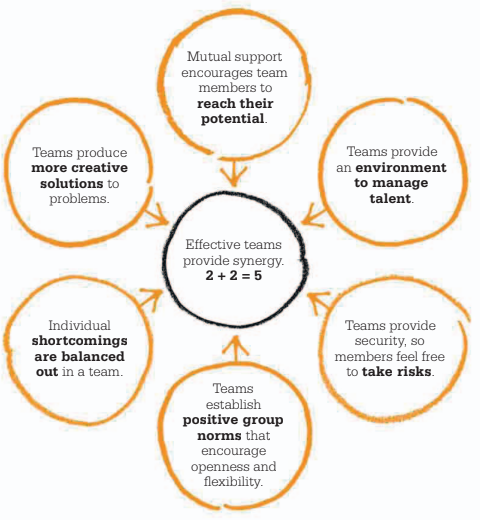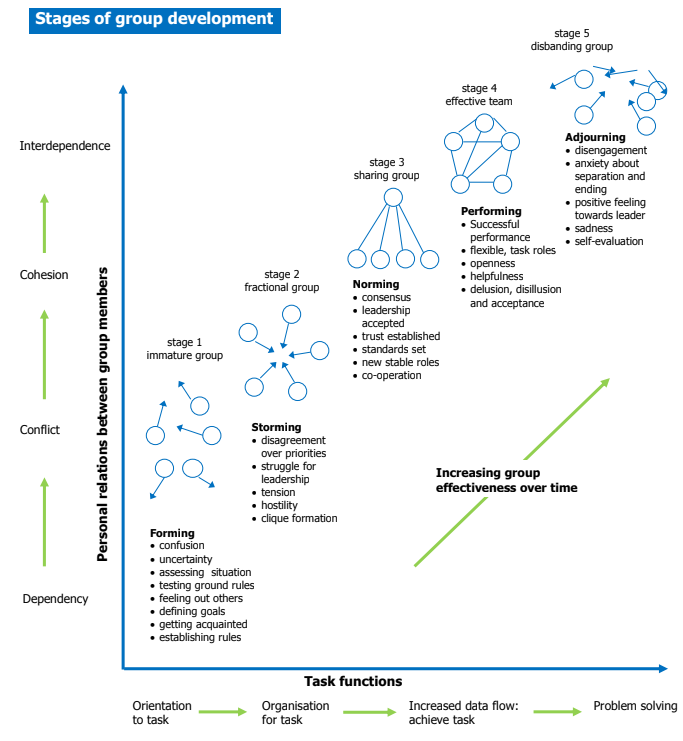
Psychologist Bruce Tuckman described how teams move through stages known as forming, storming, norming, performing, and adjourning.
Today, we're diving into the Tuckman Model of Team Development.
This model is a classic in the field of group dynamics and is widely used by managers, team leaders, and human resources professionals to understand and improve team performance.
Whether you're a team leader looking to improve your team's performance or a team member looking to understand the dynamics of your team, the Tuckman Model can help.
This model is a powerful tool that can help you understand the stages of team development, the challenges that teams face, and the strategies that can be used to overcome those challenges.
So, let's get started and explore the Tuckman Model of Team Development together!
Maybe it is possible to say that has never been a time of greater conflict between members of newly formed teams than during today’s world of huge corporate change, where relationships are made and changed so fast.
Effective teams take time to develop, right?
It is rare that a group of people can come together and begin to perform immediately.
The most common is that teams go through a series of different levels before effectiveness is achieved.
 |
| Image: Big Ideas Simply Explained - The Business Book |
In 1965, Bruce Tuckman identified four stages of development – forming, storming, norming, and performing - that every team experiences. In 1977, Tuckman, jointly with Mary Ann Jensen, added a fifth stage to the four stages: adjourning
The team growth framework suggests that unless the issues of processes and feelings have been satisfactorily addressed, it is unlikely that the team will reach the most productive final fifth stage.
As all stages have their own focus, they also correspond to a different set of feelings, behaviors, and group tasks.
 |
| Image: Okpalad, based on Tuckman and Jensen |
Forming: In the first stage of group development, a new team is formed and everyone in this team shows their best attitude, trying to build a polite atmosphere. From a leader's perspective, strong guidance is needed, considering that the objective and goals of the team are not clear yet.
Storming: In the second stage, some guidance is needed by the leader to help the team starts to gain trust in each other, but some lack of progress could be common and frustration with the goals not being achieved are common, where some conflicts occur. They start to learn about individual working styles and what it is like to work with each other as a team.
Norming: Just in the third stage, the team members start to agree on their differences, appreciate others' strengths, and respect the guidance of the leader. Resolved disagreements and personality clashes result in greater intimacy, and a spirit of cooperation emerges
Performing: With some team norms and roles established, group members focus on achieving common goals, often reaching some level of success as a team. Team confidence makes team roles more fluid and more tasks can be delegated by the leader.
Adjourning: When all tasks are completed, it’s a moment to celebrate the team’s positive goals achieved. Letting go of the group structure after long periods of intensive team work can also generate uncertainty for individual team members, once that involves completing the task and breaking up the team.
 |
| Image by Rebecca Nestor for Aurora, 2013 |
The team also needs to be trained in how to resolve its inevitable conflicts during the storming phase of the Tuckman Model. The team will use its knowledge of conflict resolution to come up with agreements and rules for the norming phase of the model.
The problem is that all these team formation models assume leaders build their teams from scratch, carefully choosing members and setting direction and goals very clearly from the very beginning, which we know is not the reality.
There are several ways to improve team maturity and move through the stages of the Tuckman Model:
Encourage open communication: Encourage team members to speak openly and honestly about their thoughts, feelings, and concerns. By fostering an environment of open communication, team members will be more likely to trust one another and work together effectively.
Promote active listening: Encourage team members to actively listen to one another, and make sure that everyone has a chance to speak and be heard.
Set clear goals and roles: Clearly define the team's goals and the roles of each team member. This will help ensure that everyone is working towards the same goal and that everyone knows their responsibilities.
Provide regular feedback: Regularly provide feedback to team members on their performance and progress. This will help team members understand what they are doing well and where they need to improve.
Facilitate team bonding: Encourage team members to bond and build relationships outside of work. Activities such as team-building exercises, social events, or team lunches can help team members connect and build trust.
Encourage mutual support: Encourage team members to support one another and provide help when needed. This will help to foster a sense of teamwork and cooperation among team members.
Celebrate successes: Celebrate the team's successes and acknowledge the contributions of each team member. This will help to build morale and motivation among team members.
Encourage team decision-making: Encourage team members to participate in decision-making processes, and make sure that everyone's input is considered. This will help to create a sense of ownership and commitment among team members.
Foster an environment of continuous learning and development: Encourage team members to continuously improve their skills and knowledge, and provide opportunities for learning and development.
In conclusion, the Tuckman Model of Team Development is a powerful tool for understanding and improving team performance.
It provides a clear framework for understanding the stages of team development, the challenges that teams face, and the strategies that can be used to overcome those challenges.
By understanding the model, team leaders can better identify the stage their team is currently in and take appropriate action to move the team forward. Team members can also gain a better understanding of the dynamics of their team and how they can best contribute to the team's success.
Overall, the Tuckman Model is an essential tool for anyone looking to improve their team's performance and create a more effective and cohesive team.
We hope this post has been informative and helpful in your understanding of the Tuckman Model.
References, inspirations, recommendations, or further reading:
- Developmental Sequence in Small Groups by Bruce Tuckman
- Stages of small group development revisited by Bruce Tuckman
- The Five Stages of Project Team Development
- Tuckman's Stage of Group Development
- Tuckman (Forming, Norming, Storming, Performing)
I am incredibly grateful that you have taken the time to read this post.
Your support and engagement mean the world to me, and I truly appreciate your interest in the topics I write about.
I hope that you have found this post informative, educational and engaging.
If you are interested in reading more of my work, please visit other articles here on the website.
I promise to continue providing valuable and high-quality content for your enjoyment and education.
Thank you again for reading and I hope to see you soon!
Here are some related articles you may enjoy:
There are even more good things I've prepared for you!
Subscribe below or click here to receive new posts in your Email!
Do you want to read some book notes and recommendations? Discover more here!
Do you want to have amazing weekly content curation? Discover more here!
Ready to make a positive impact?
Support my work by sharing my content with your network.
Your simple act of kindness can reach new heights and help spread valuable information.
Want to show your support in a tangible way? A virtual coffee is a small but mighty way to show your appreciation and give me the extra energy to keep crafting valuable content!



